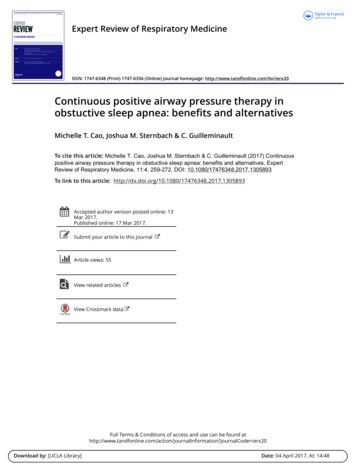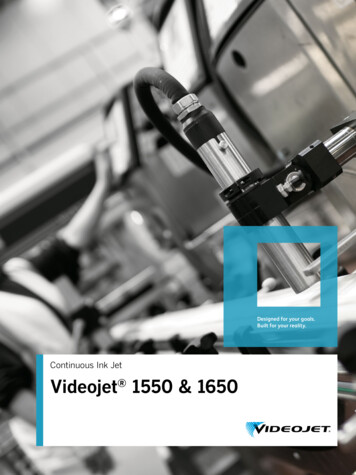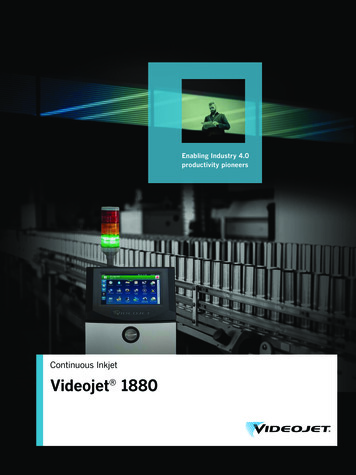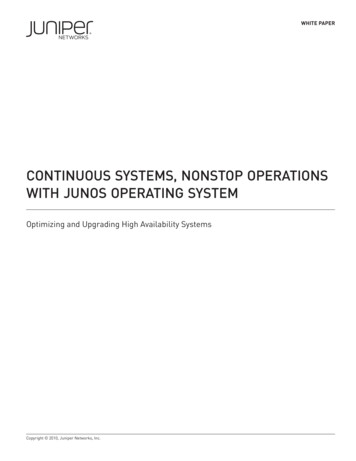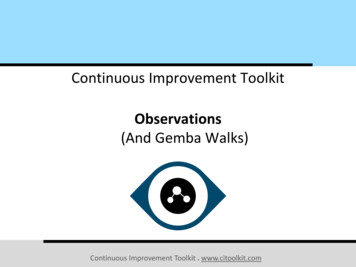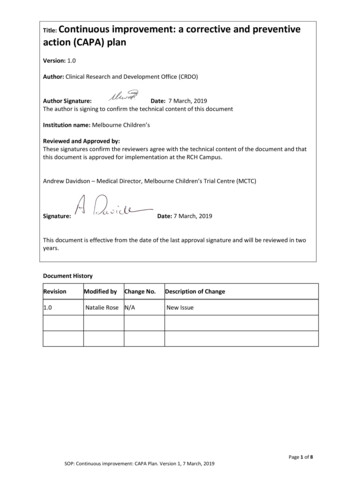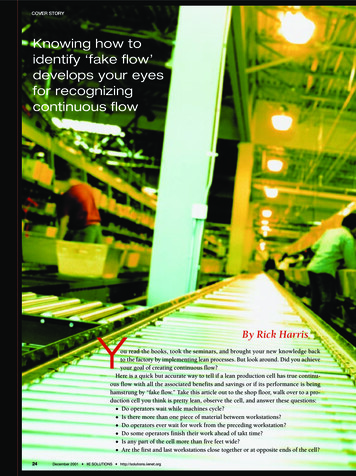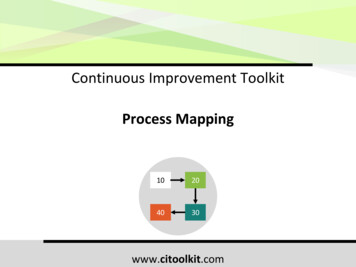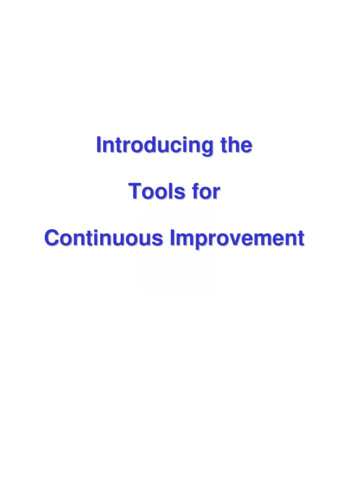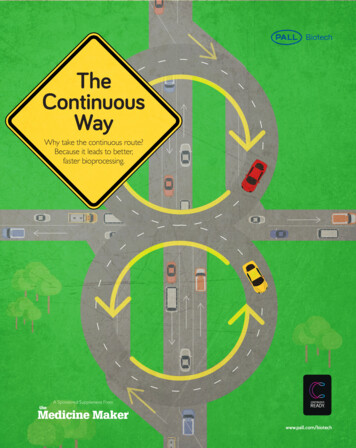
Transcription
TheContinuousWayWhy take the continuous route?Because it leads to better,faster bioprocessing.A Sponsored Supplement Fromwww.pall.com/biotech
Meet the ExpertsMarc BisschopsDirector SLS, Continuous Bioprocessing,Pall BiotechJonathan HummelJessica Chia-Yun SunCharles CooneySenior R&D Engineer, Pall BiotechRobert T. Haslam (1911) Professor of Chemical andBiochemical Engineering, Emeritus, Department of ChemicalEngineering, Massachusetts Institute of TechnologyBioprocess R&D Engineer, Pall BiotechVice President Technical Services &Scientific Affairs, Pall CorporationMani KrishnanHoward LevinePeter LevisonMark PagkaliwanganMario PhilipsSenior Marketing Director, DownstreamProcessing, Pall BiotechRachel QuesenberrySenior R&D Engineer, Pall BiotechBioprocess Engineer, Pall BiotechMark SchofieldSenior R&D Manager, Pall BiotechPresident and CEO of BioProcessTechnology Consultants, IncVice President and General Manager,Pall BiotechMartin SmithChief Technology Officer,Pall Corporation 2018 Pall Corporation. Pall, Acrodisc, Cadence, HyperCel and Mustang are trademarks of Pall Corporation. indicates a trademark registered in the USA. Orkambi is a trademark of Vertex Pharmaceuticals Incorporated. KANEKA KanCapA is a trademark of KANEKA Corporation.
A New Chapter for Continuous BiomanufacturingAt last, the industry is entering the era of continuousbioprocessing and improved production efficienciesThe sunk costs of large stainless steel plants, togetherwith regulatory barriers to process change, havetraditionally disincentivized the departure from triedand tested batch manufacture. Recent years, however,have seen dramatic changes, not least growing cost-containmentpressures on healthcare providers and systems. This, togetherwith the emergence of innovative products and processes, ismaking the switch to continuous increasingly attractive.As with all evolutionary change, the appearance of continuousbioprocessing is the end result of a gradual process. Changebegan some 15-20 years ago with demonstrations of the costsavings that could be derived from replacing stainless steelsystems with single-use components, and continued with theintroduction of even more efficient modular systems. Put simply,continuous processing is the natural next step, and the evolutionof this approach is reflected in the rate of adoption of continuousprocessing across many industries. As with single use, biologicsmanufacturers want reassurance in the form of data beforethey make the change; in particular, they require evidence ofscalability before investing in new process technology. Since dataon many continuous technologies is only generated at small scale,it sometimes seems that the clinical or production scale viability ofnew technology relies on aspiration rather than demonstration!At Pall, we ensure that our innovations are supported withdata, especially with scale up. Using economic models, weprovide demonstrably compelling data for the superior costeffectiveness of continuous systems; this important informationis discussed in more detail on page 8. Our data-drivenapproach has enabled us to introduce a portfolio of continuousprocessing innovations. More recently, we turned our attentionto diafiltration – the one unit operation of biomanufacturingprocesses that had never before been modified for continuousoperation – and our inline diafiltration product was launchedin 2017. Future advances will include acoustic wave separationmethods for continuous clarification of perfusion cell culture.My conclusion? This is a new chapter for biologicsmanufacturing; the time has come for continuous processingto be broadly implemented in biomanufacturing. The economicadvantages are irrefutable, and the disadvantages associatedwith regulatory risk or system complexity no longer exist. Pallhas invested broadly and deeply in this field, and stands readyto support companies in each phase of this continuing evolution.F o r ew o r dContentsForeword02 A New Chapter forContinuous BioprocessingFeatures04 Driving the Move toContinuous Bioprocessing06 In Pole Position08Economical Truths12ContinuousChromatography:Workhorse andRacehorse16Continuous Success:Establishing a ContinuousBioprocess Platform18Continuous Processing isStill ProcessingThought Leader Interview22 Featuring Charles Cooneyfrom the MassachusettsInstitute of TechnologyPeter LevisonSenior Marketing Director, Downstream Processing,Pall Biotechwww.pall.com/biotech
4 S p o ns o r e d S up p l e m e n tDriving the Moveto ContinuousBioprocessingWhy turn away from establishedbatch manufacture? Becausecontinuous bioprocessing candeliver increased efficiency andimproved economics.By Howard LevineBatch processing has been the norm inpharma and biopharma manufacture fordecades, so why should the industry considercontinuous processing? Simple: continuousprocessing has been the natural evolutionfor manufacturing in a number of industriesthat have already made the switch, includingpetrochemicals, food and automotive. Withcontinuous technologies for pharmaceuticals– and more recently biopharmaceuticals –now becoming available, companies finallyhave the opportunity to embrace thebenefits offered by continuous processing– and it’s fair to say that the industry is longoverdue an update. In 2011, at the AAPSAnnual Meeting, Janet Woodcock famouslyremarked that manufacturing expertsfrom the 1950s would “easily” recognizethe pharma manufacturing processes oftoday. She also added, “It is predicted thatmanufacturing will change in the next 25years as current manufacturing practices areabandoned in favor of cleaner, flexible, moreefficient continuous manufacturing”.In the past, the FDA was perceived tohave an “enforcement first” mentality,but Woodcock’s comments signaled thatthe agency was open to manufacturinginnovation that could benefit productquality and patients. In fact, the agencyhad already been encouraging companiesto examine how they could improvetheir manufacturing processes, with manymodern manufacturing concepts includedin the agency’s 2004 guideline,“Pharmaceutical cGMPs for the 21stCentury: A Risk-Based Approach”. It’sfair to say that the industry has takensome time to embrace continuousprocessing – the first regulatoryapproval of a continuous process for asmall-molecule drug product (Vertex’sOrkambi ) came in 2015 – but thetide is turning, and now it is time for thebiopharma industry to get on board. Frommy perspective, continuous bioprocessingoffers several compelling advantagesfor manufacture: it is more efficient, it ismore economical, it is more flexible, andalso improves overall product quality andconsistency – an aspect that is of particularinterest to regulators.Defining continuousA continuous process can mean differentthings to different people. From a conceptualstandpoint, a continuous process basicallymeans something that, once turned on,continues indefinitely – processes in thesteel industry and the automotive industryare often run this way. However, in thebiopharmaceutical industry, a continuousprocess may be slightly different. For example,a process that runs for a defined period oftime, with minimal intervention and withoutsignificant breakpoints in the process.In the traditional pharma sector, thereis a growing trend towards larger scalemanufacturing to produce increasedquantities of product to meet global demand.This concern has spread to the biopharmasector, as well as worries that some currentbatch processes and facilities may not meetglobal demand for high volume biologicproducts. Continuous processing lends itselfvery well to the ongoing production of largequantities of product, and so could providea solution to this potential issue. At the sametime, many companies are also developingdrugs targeted to smaller, niche marketswith fewer patients. For these products,there is concern that traditional batchmanufacturing at small scale may not be costeffective, especially with growing pressureto reduce the cost of medicines worldwide.Once again, continuous manufacturing couldprovide a solution by bringing increasedflexibility and the ability to produce moredrug product in less time, using smallerfacilities and lower capital investment thanbatch manufacturing.Continuous systems also allow for muchhigher rates of equipment and facilityutilization as traditional batch processes,using fixed stainless steel systems or evensingle-use systems, are not used as efficientlyas possible. For example, cleaning andchangeover times for a large stainless steelproduction bioreactor may approach theactual production time for the reactor.Switching to continuous processing allowsmanufacturing assets to be run 24/7, whichcan have a significant impact on cost of goodssold, as well as the size of a facility. Smallerfacilities mean smaller workforces andlower capital investments – hence, lowercosts. Small facilities making maximal useof single-use systems, modular design, andcontinuous processing technologies (the threecomplement each other very well) are fasterto build, meaning that investment decisions canbe delayed until later in the development cycleof a new drug or until sufficient informationregarding expected demand is available.Start up of a new continuous manufacturing
line may require only a few months, asopposed to several years for a largestainless steel factory.Aside from lower costs and moreflexible manufacturing solutions,continuous manufacturing may alsoreduce the “waste” associated withbiologics manufacturing, including batchvariation, equipment and facility downtime, costs of transporting product fromone unit operation to another, qualitycontrol at the level of individual unitoperations, and variation of raw materials.Continuous processing, coupled withadvances in Process Analytical Technologies(PAT) may also further reduce the qualitycontrol burden on manufacturing, furtherstreamlining manufacturing operations.Although much attention aroundcontinuous bioprocessing has focusedon process economics, the time benefitsare also significant. It is widely knownthat manufacturing costs have a relativelysmall influence on the final price of adrug. A far larger influence is exerted bythe need to recoup the costs of faileddrugs in the company pipeline. Becauseof this, companies are seeking to developtechnologies that allow them to acceleratedevelopment and determine soonerwhether or not a potential drug candidatewill work sooner to allow them to cut theirlosses and move on. Small-scale continuousbioprocessing can enable the rapid, costeffective production of clinical trial material,allowing companies to reach the failurepoint sooner – as developing manufacturingprocesses and producing clinical trialmaterial is often the rate-limiting step toinitiating clinical trials. Shorter developmenttimes and faster manufacture would speedup the transition from product concept toa first-in-man clinical trial, accelerating drugdevelopment and inevitable failures.Embracing changeThe biopharma industry is currently splitbetween those who believe there is a futureFigure 1: Estimating the value of a flexible supply chain. Use of flexible technologies reduces theoverall manufacturing investment from development through commercial launch, while reducing risk.Figure 2: Continuous bioprocessing will allow for the use of smaller, integrated equipment.for continuous processing in our industryand want to embrace the technology andthose who feel it is unnecessary. In manycases, it is the larger, established companieswho fall in the latter camp, rejectingcontinuous bioprocessing, perhaps becausethey have already invested heavily in stainlesssteel facilities and batch manufacturing.Some companies also have the erroneousbelief that continuous processing is difficultor unproven, even though it has beeneffectively implemented for years in manyother industries. That said, not all largepharma companies are standing idly by;companies such as Sanofi, Bayer, Novartisand Amgen are actively developingcontinuous bioprocessing programs.Continuous manufacturing for smallmolecule drugs is becoming increasinglycommon – particularly for new productlaunches. Continuous bioprocessing,however, is still in its infancy. As with anynew technology, change is difficult for myriadreasons. Typically, the mentality of “but wehave always done it this way and this wayworks very well” persists until there is an issuethat the current way of working cannot solve!The move to continuous bioprocessing mayseem daunting, but the technology reliesupon single use, which is now well establishedin the industry. In addition, with suppliers likePall garnering experience in the field, theswitch does not have to be made alone.Given that the FDA has embracedcontinuous processing so enthusiastically, it ishard to imagine a future for bioprocessing thatdoes not involve continuous technologies.In fact, industry experience across sectorssuggests that, if companies are to reducecosts and remain competitive, continuousprocessing is not optional, but essential.Howard L. Levine, Ph.D. is President and CEO ofBioProcess Technology Consultants, Inc.www.pall.com/biotech
6 S p o ns o r e d S up p l e m e n tIn Pole PositionContinuous bioprocessing hasalways had the potential to makea big difference in biopharmamanufacturing, but someonehad to lead the pack. Pall is thefirst supplier to truly embracecontinuous technologies.By Martin Smith and Mario PhilipsDiscussions around the potential ofcontinuous bioprocessing s tar tedover a decade ago – there were manyconferences around the topic, but thelack of technology solutions, as well asuncertainty over how regulators wouldreact, prevented any serious changesfrom taking place. At Pall, we havealways viewed ourselves as a premiumtechnology supplier, as well as a marketleader in our fields of activity. Indeed,we have been at the forefront ofbiologics production since its beginningsin the eighties and we are also a Tier1 supplier in the markets we serve.We made the decision to commit tocontinuous bioprocessing a few yearsago. Why? Mainly because of the manychanges occurring in the industry. Everygovernment in the world is trying todrive down the costs of their healthcaresystems, there is growing competitionin the biopharma space, and a movetowards niche medicines that cater tosmaller numbers of patients.The industry needs more cost effectiveand f lexible manufacturing – andcontinuous bioprocessing is the answer.For change to take place, however,companies need to start committing.Pall is the first company to providecontinuous bioprocess options for eachstep of the downstream process.It is neither useful nor effective to createa continuous bioprocess simply by boltingtogether old batch operations and thetechnologies therein; integration requirescareful management of flow rates, titersand so on – and such constraints mustbe addressed by new technologiesand systems specifically designed forcontinuous operations. Pall has reengineered every single stage of thedownstream biopharmaceutical process,and we now have a fully continuous, endto-end, in-house manufacturing system inWestborough, MA, USA (no bigger thana normal wet lab). By the end of 2017, wehad also launched a range of differentcontinuous systems that allow ourcustomers to remain in continuous modefrom process development through tofully scaled-up operations.It really works!Not every player in the biopharmaindustry has bought into continuousbioprocessing, and we hear commonconcerns. Perhaps the most prevalentmisconception is that continuoustechnology simply “doesn’t work” – butit really does! We have demonstratedcontinuous chromatography, continuousclarification from a bioreactor, andcontinuous concentration of a fluids tream. We of fer an on-site tr ialprogr am to show customer s thattheir unit operations will work in anew, continuous modality. Anotherfrequently raised issue is the idea thatthe regulators won’t accept continuous,but this is also a falsehood. Regulatorswant better drugs to reach the marketfaster, and their desires for morestreamlined biologics production canbe met by continuous bioprocessing.They clearly still need to see validationdata, but this is not the same as beingantagonistic to the concept.It is true, however, that continuousprocessing is not a good match forevery company. A multinational pharmacompany will have needs and constraintsthat differ from a biosimilars company,for example, and a biosimilars companywill differ from a small biotech. Thatsaid, one of the great advantages ofcontinuous processing is its flexibility: itcan accommodate the demands of a topten pharma company looking for an endto-end continuous process, but can alsobe applied to individual unit operationsor clusters of unit operations that mightbe of interest to smaller companies.When a company is first looking toexplore continuous bioprocessing, itcan be challenging to know where tobegin, but it is no longer necessaryfor companies to rely completely ontheir own resources. At Pall, we haveexper ienced the implementationof a continuous bioprocess, so weunderstand the issues that may ariseand how they can be fixed. We startedout by designing and running small-scalebioprocesses on a continuous basis, buttoday our Westborough lab runs a linethat produces monoclonal antibodies atlarge scale, on a continuous basis. Ourinitial target was to produce 100 gramsof monoclonal antibody in 24 hours,starting from a 200 liter bioreactor – andwe have accomplished this. We now feelthat we could produce more product inthe same time from a higher titer culture!We have also expanded our suite ofcontinuous process instrumentation toaddress some of the aforementionedregulatory requirements.Customer feedback on our productsand development efforts has been veryenthusiastic, but we find that most preferto adopt continuous systems in a stepwise fashion; for example, manufacturersmay wish to intensify two or three stepsout of fifteen. Very often, the driverfor change is to reduce the cost ofmanufacture, such as by using less proteinA in the chromatography stages; when weexplain that continuous chromatographyrequires seven-fold less sorbent thanbatch process chromatography, weusually get people’s attention! As a
S p o ns o r e d S up p l e m e n t 7Continuous Lab at Pall Biotech’s New England Center of Excellence - Westborough, MA, USA.starting point, customers may implementcontinuous chromatography, but retainconventional batch processes upstreamand downstream of that.In time, as continuous bioprocessesbecome more established, we expectto see customers reviewing theirdevelopment pipelines to identify whichnew products can employ continuousbioprocessing from the very beginning.We are already being asked to supportclients in setting up fully continuous lines,similar to our Westborough set-up, forclinical grade production. Integratingmany different continuous operationsinto a single, efficient and seamlesssystem is not trivial at any scale, so anexperienced partner can make a bigdifference. In addition, for clients thatdo not have the time to rigorouslyevaluate and develop a new continuoussystem, Pall can do it for them off-site,and then transfer the process across ata convenient time.Continuous developmentAt present, Pall can offer four individualclusters of bioprocess intensification: bioreactor, clarification and sterilefiltration operations in-line concentration,chromatography, virus inactivationand sterile filtration operations chromatography polishing viral filtration, concentration, finalformulation and filling operations.We are also pushing ahead with thedevelopment of advanced automationsystems for monitoring and controllingcontinuous processes, which will beessential to truly advance the field ofcontinuous bioprocessing. However,technology is not the only importantenabler of continuous bioprocessing;Pall has not become a leader in thefield just by selling products to people– it is because we work with th
BioProcess Technology Consultants, Inc. Figure 1: Estimating the value of a flexible supply chain. Use of flexible technologies reduces the overall manufacturing investment from development through commercial launch, while reducing risk. Figure 2: Continuous bioprocessing will allow for the use of smaller, integrated equipment.

